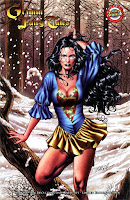GFT Retrospective #34: Rip Van Sela
This is your morning wakeup call, Ticketholders!
It's time for today's edition of the Grimm Fairy Tales Retrospective.
 Grimm Fairy Tales #30: Rip Van Winkle is another mind-trip issue, with the reaper figure from the 2008 Annual coming to pay his respects to Sela following her death at the end of Snow White and Rose Red. Though Belinda ran her through from behind with a very long sword (Excalibur, if I remember correctly), Sela is not bleeding. Either it’s been awhile since she was killed and the wound coagulated shut, the artist was lazy and/or forgetful, or because magic. Keep that third option in mind.
Grimm Fairy Tales #30: Rip Van Winkle is another mind-trip issue, with the reaper figure from the 2008 Annual coming to pay his respects to Sela following her death at the end of Snow White and Rose Red. Though Belinda ran her through from behind with a very long sword (Excalibur, if I remember correctly), Sela is not bleeding. Either it’s been awhile since she was killed and the wound coagulated shut, the artist was lazy and/or forgetful, or because magic. Keep that third option in mind.As seems proper to the reaper--and it is, because this is Grimm Fairy Tales, after all--he says goodbye in the only way Sela would respect (or find blasphemous): by telling her a story from Sela’s own book.
In what he calls "Sela’s version" of Rip Van Winkle, it turns out that Robert wasn’t her first love. Long before Robert (assuming this is a flashback fairy tale and not entirely a head-trip), there was Rip Van Winkle, father to her two children and love of her life.
But when she falls asleep one day, her reprieve from duty as champion and savior of humanity is interrupted by a dream sequence that reveals a future world without her influence. In this future reality, the Wonderland beast, a knight in dark armor, a man sitting on a throne with crocodiles at his feet, the Cheshire Cat, Belinda, and several undefined other villainous figures (rendered in kaiju monster size because dreams, I guess) have taken over the world. And despite her not having aged in at least three hundred years, dream Sela has white hair and wrinkles. It reminds me of how Ash falls asleep at the end of Army of Darkness and wakes up with white hair and a really long beard, only to look perfectly normal again in the Ash VS Evil Dead TV series. Makes no sense at all. But, we’re reading Zenescope comics, so nonsense always makes sense now, even when it’s not a Wonderland title.
Whether fairy tale Sela decides to re-embrace her destiny is unclear, according to Offensive Asian Stereotype Man and what I assume is Zenescope’s sexified version of Tinkerbell, but remember how I mentioned magic healing powers? As the reaper walks away, delivering a few parting words on the final two-page splash, Sela’s eyes shoot open.
When I first saw this last collection of images back then and realized what it meant, I about lost my mind at the cool factor.
If there are any three things that have impact in comics, they are good origin stories, times when a superhero gives up or dies, and when a hero comes back from the dead. While Sela’s origin story is kind of slapped together by committee and the circumstances surrounding her fall, redemption, death, and resurrection are on par with the kind of cosmic nonsense you’d find in an old Doctor Strange issue, the defining moments themselves have been consistently dramatic punctuations, as any good twist should be.
Tune in tomorrow for the Volume 5 short story.
Ticketmaster,
out.



Comments
Post a Comment